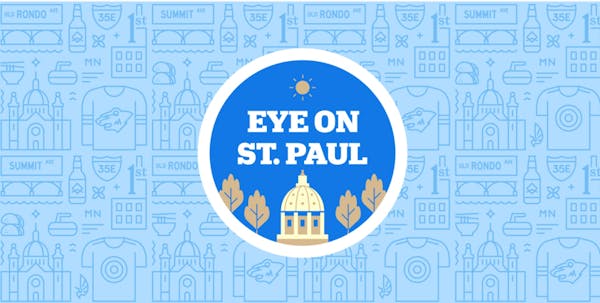In June 2015 — at a time when it seemed small independent bookstores were going the way of buggy whips and VHS tapes — St. Paul's SubText Books made a decision: Not only would it continue as a brick-and-mortar bookstore, but it would move downtown.
SubText previously filled a basement space in the Blair Arcade, beneath Nina's Coffee Cafe. Matt Keliher, the store's manager and book buyer, said SubText was enticed downtown by an attractive sales pitch — and it was time to come up from underground.
While the COVID-19 pandemic siphoned away some of SubText's momentum, Keliher said the bookstore has made the kinds of structural changes that not only have helped it survive, but cater to downtown's growing residential population.
In a recent interview with Eye On St. Paul, Keliher talked about how SubText continues to thrive, serving people drawn to the unique charms of a small, independent bookstore.
This interview was edited for length.
Q: Why did you take the plunge to move downtown in June 2015?
A: Just getting above ground made a huge difference to us. Also, downtown St. Paul felt like it was ripe for an opportunity. It needed a bookstore. John Rupp at the time owned the building and made a pretty compelling pitch [to store owner Sue Zumberge]. And we have absolutely loved it here.
Q: What does SubText offer that people can't find at Amazon? And what is the trick to surviving as a small bookstore?
A: We try to focus on books from small, independent presses. Mostly, we sell the same product that Amazon does but we offer a largely different experience.
It's the way in which we can connect with people in our community and create an environment that is welcoming. It's what brings value to the neighborhood and I think people recognize that and respond to that.
Q: Talk a little about the environment here. You have couches, nooks and crannies.
A: People need a place they can go that isn't a bar or a restaurant. This offers an escape for people. An oasis. They can sit on a couch, curl up with a book. And get away.
Q: I notice you have all these little handwritten book reviews tucked under books on the shelves. What are those?
A: They're called shelf-talkers and they've been around for many years at a number of different stores. I can't take credit for that. But it is another value to small bookstores.
It allows people to discover something. I often tell people that the fun thing about bookstores is that you might come in looking for a certain book but the book that excites you most is the one sitting next to it.
Q: What has been your experience since moving downtown? Any surprises?
A: When we first moved down here, we recognized there was a large business community that was here from 9 to 5 [an estimated 55,000 workers]. There was also a lot of tourism, or business tourism. People coming from the RiverCentre or to conventions.
I think the thing that surprised me the most is the community of people who live down here [more than 10,000], or right up the hill or on the West Side that want to see downtown thrive. St. Paul has changed a lot in the last 15 years. Downtown St. Paul has changed a ton in the last five years. When we first came down here six years ago, people were like, "Why are you going downtown? Tumbleweeds are blowing through downtown at night." While COVID has obviously changed a lot, right before that, downtown was the best that it had ever been.
Q: Can you get back to that?
A: That's a good question. I mean, it remains to be seen. It was worse last year than it is now. Bookstores like ours in a space like this sort of depend on the symbiotic relationship between coffee shops and the restaurants and the hotels and the events.
Even in the last few months, things have started to creep back to normalcy. The Wild is back and having events that bring people from out of town. The Ordway and the Palace Theatre are back, so a lot of that stuff is sort of returned. The piece that remains to be seen for me is the workers coming back to the office. In St. Paul, in particular, there are a lot of city, county and state employees who work down here. They were expected to come back and they will come back, but they were supposed to come back in September. Then they pushed it back. In March, it will be a full two years.
Q: How have you survived?
A: [Points to a stack of books waiting to be shipped — "The 1619 Project"— that went on sale the day of our interview.] We have about 45 pre-orders for this book, which means that people ordered it some months ago. We never would have had a 40-book pre-order before this. Some of that is the website being more efficient and easier to operate. Some of it is the [book]. But it's a huge piece of the pie for us.
In 2019, book orders probably comprised 5% of our business. Last year, it probably comprised 35%. This year, it's maybe 60% of our sales. A lot of that is permanent. Personally, I would like to see it get back to more in-person. I just miss talking to people.






